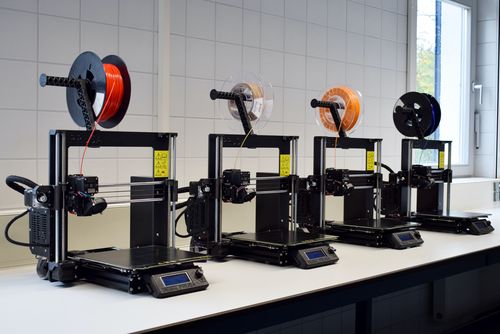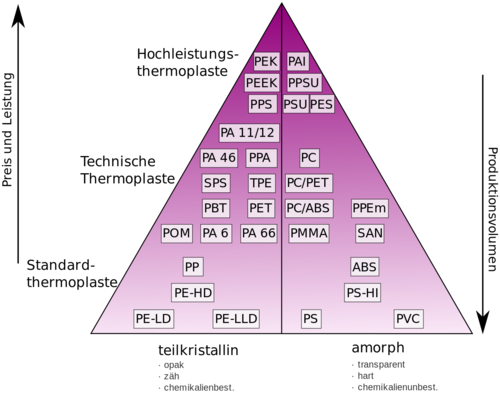Fused Filament Fabrication (FFF)
Fused Filament Fabrication (FFF)
The most widely used printing process is the Fused Filament Fabrication process. The process was invented by the Stratasys company at the end of the 1980s and protected in the 1990s under the trademarked name “Fused Deposition Modeling (FDM)”. The principle is based on layer build-up with thermoplastic materials. The printer is loaded with the desired filament and is thus prepared for printing. The filament is conveyed by a drive (extruder) to the hot end. The hot end heats the material to its melting temperature, which causes the plastic in the nozzle to become viscous. Due to the permanent conveying of the material, the liquefied material is pressed out of the nozzle and can thus be applied for layer build-up. In order to be able to reproduce a model with this material, the printer still needs information, the G-code. This is a machine language that is also used in commercial metal-cutting production. This translates the contours of the model, considering the corresponding machine parameters such as nozzle diameter, layer height, printing speeds, etc., into coordinates that the print head hot end moves to, coupled with the material feed. In this way, the desired print model is built up layer by layer. The parameters are of course dependent on the desired material or the quality demand on the component.
Structure of FFF 3D printer
Here is an overview of the essential components of the FFF 3D printer.
1: Material coil
2: Printing Filament
3: Support filament
4: Hot end with nozzle
5: printed component
6: Support structure
7: Building platform
Materials
The material for the FFF process is generally called filament. Meanwhile, many plastics are available in any colors from a variety of manufacturers. It is wound onto a spool in wire form and can be unwound and printed directly from the spool. Spools are available from 0.25 kg up to 10 kg depending on the material. In general, except for a few exotics, there are two different sizes in diameter. 1.75 mm and 2.85 mm have become established here with most manufacturers for 3D printers, with the smaller variant being used most frequently. The processability of the different materials ranges from simple (PLA) to heavy (PEI, PEEK), which also always sets requirements on the 3D printer. Not all materials available in filament form can be printed with every FFF printer. The requirements here are primarily directed at the temperature management in the printers. Nozzle, build room and bed temperature, as well as the cooling of the mechanics and electrics.
The pyramid above shows an extract from the available plastics. Almost all of these plastics are now available for the FFF process. In order to find the right plastic for a specific application, the relevant literature must be used.
FFF printing with metal
An exciting material for FFF 3D printing is a material mixture of a polymer matrix and metal powder in a mixing ratio of approx. 20/80. This material has already been used for years in injection molding technology and now it is slowly finding its way into the FFF process. If this material is used for printing, the chain process includes additional work steps on the way to the finished component. After the component is designed, it must be scaled up with the appropriate shrinkage factors of the material. The shrinkage is between 16% and 20% depending on the spatial direction. When the component is then printed with the corresponding material parameters, it is referred to as a green part or green compact. Here, the chain process now differs from conventional FFF printing, since the component must be debinded subsequently. This means that the binder material is separated from the steel. This can be done thermally using nitric acid or chemically. What remains after this process is called the brown part. It is a “steel skeleton” held together by a residual binder. This very unstable component is then transferred to the sintering process. Here, the component is slowly heated to a certain temperature and remains there for several hours. During this process the component shrinks together and becomes a solid metal part. After cooling, the part can be reworked and put to use.
The great advantage of this process is that there are no large initial costs for a 3D printer. It is already possible to achieve relatively good results with a printer in the three-digit range. However, the subsequent processes such as debinding and sintering are a cost factor of around €70 per kilogram and the material costs over €150 per kilogram.





